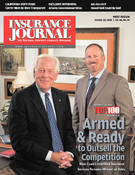American International Group’s (AIG) exposure to the subprime mortgage market that precipitated the government’s $85 billion bailout came as a result of business conducted after he left the company, according to Maurice “Hank” Greenberg, who was CEO from the late 1960s until first quarter 2005.
Greenberg was at the helm in 1987, when AIG Financial Products was born, and in 1998, when it started getting involved in credit default swap insurance. But Greenberg said in recent Congressional testimony that AIGFP was not involved in much subprime while he was in charge.
Greenberg left AIG in March 2005 in the wake of a probe into accounting practices at the company. He has denied any wrongdoing. He was AIG’s largest individual shareholder before the bailout.
Martin Sullivan, who succeeded Greenberg as CEO, suggested he was focused on other priorities including repairing AIG’s standing with customers and regulators, cooperating with several government probes and helping manage losses from Hurricane Katrina. His efforts succeeded, he said, as AIG enjoyed good years in 2006 and most of 2007.
“However as we now know, a different storm was gathering over the global financial markets,” Sullivan acknowledged.
The two told their tales in testimony given to the House Committee on Oversight and Government Reform. Robert Willumstad, the AIG board chairman who succeeded Sullivan as CEO on June 15, also testified.
Greenberg recalled how AIGFP, the London-based office that grew the credit default swap business, got started. “Our AAA rating was an asset that made it possible to create AIGFP in 1987, as part of AIG’s philosophy that generating earnings from diverse business lines would add to earnings stability if any particular business unit encountered a downturn.”
In 1987, the derivative market was small but growing. Greenberg said AIG’s approach was to conduct business on a “hedged” basis, such that net profit should stem from the differences between the profit earned from the client and the cost of offsetting or hedging the risk in the market. “AIGFP would therefore not be exposed to directional changes in the fixed income, foreign exchange or equity markets,” Greenberg testified.
He said AIGFP reported directly to him and to AIG Senior Vice Chairman Ed Matthews, and later to William Dooley, senior vice president.
Greenberg said there were management controls in place under his leadership to monitor AIGFP and its risk portfolio.
“AIGFP was subject to numerous internal risk controls, including credit risk monitoring by several independent units of AIG, review of AIGFP transactions by outside auditors and consultants, and scrutiny by AIGFP’s and AIG’s Board of Directors. Every new type of transaction or any transaction of size, including most credit default swaps, had to pass review by AIG’s chief credit officer.”
Greenberg said the system worked. Yet, he said sales of credit default swaps “exploded” after he left the company in March 2005. He said AIGFP wrote as many credit default swaps in the nine months after he left as it did during the previous seven years combined.
“[U]nlike what had been true during my tenure, the majority of the credit default swaps that AIGFP wrote in nine months after I retired were reportedly exposed to subprime mortgages. By contrast, only a handful of the credit default swaps written over the previous seven years had any subprime exposure at all,” he said.
AIGFP’s exposure to multi-sector credit default swaps at June 30, 2008 was $80.3 billion, of which $57.8 billion contained subprime mortgage collateral. The mark-to-market loss on that was $24.8 billion, of which $21 billion was related to subprime. The total mark-to-market loss on the AIGFP portfolio as of June 30, 2008, was $25.9 billion, according to Greenberg.
How did the over-exposure to the subprime market happen?
“I was not there, so I cannot answer that question with precision. But reports indicate that the risk controls my team and I put in place were weakened or eliminated after my retirement,” Greenberg said. He suggested that the additional risk in new credit default swaps “appears to have been entirely or substantially unhedged.”
Sullivan denied that risk controls that were in place under Greenberg were watered down. Sullivan added that AIG heeded signs that the credit quality and pricing were changing. AIGFP stopped writing the products after 2005 and during his tenure, it was under control. “Until I left, AIG had not suffered $1 of losses” on credit default swaps.”
Sullivan said that “unintended consequences” of one accounting rule was a factor in AIG’s downfall. The FAS 157 accounting rule required AIG to mark its assets to market value even during a distressed market. “Companies must declare these values on their books even if they have no intention, or immediate need, to sell the assets, even if they have not realized any actual gain or actual loss.”
AIGFP had intended to retain its interests in credit default swaps until they reached maturity, but instead it was forced to mark them at fire sale prices. The company was forced to report billions of dollars of “unrealized losses” on the basis of the then-current market valuations.
Willumstad, who was CEO after Sullivan was terminated until the government stepped in, promised a liquidity plan by Sept. 25. But rating agencies would not wait.
A domino-like series of repercussions followed the writedowns. Sullivan said AIG got caught in a “global financial tsunami.”
“I don’t believe AIG could have done anything differently. There was no private market solution,” Willumstad said.
Topics Profit Loss AIG
Was this article valuable?
Here are more articles you may enjoy.


 State Says Exiting Steward Health Lacks Required Insurance for Employees, Physicians
State Says Exiting Steward Health Lacks Required Insurance for Employees, Physicians  Progressive to Pay Policy Limits in Fatal Boat Crash That Involved Murdaugh’s Son
Progressive to Pay Policy Limits in Fatal Boat Crash That Involved Murdaugh’s Son  Howden Alleged to Have Poached Insurance Rival’s Team in UK Suit
Howden Alleged to Have Poached Insurance Rival’s Team in UK Suit  Combined Losses From Milton and Helene to Be $35B-$55B: Moody’s RMS
Combined Losses From Milton and Helene to Be $35B-$55B: Moody’s RMS 


